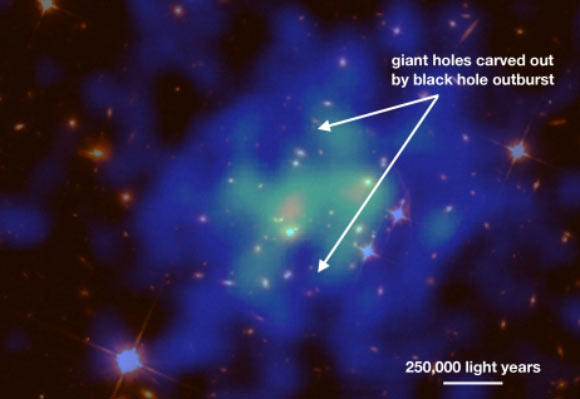Astronomers Witness Extremely Powerful Black Hole Outburst in Distant Galaxy Cluster | Astronomy – Sci-News.com
Astronomers using NASA’s Chandra X-ray Observatory have spotted an unusual outburst activity in the center of SPT-CLJ0528-5300 (SPT-0528 for short), a galaxy cluster located approximately 6.7 billion light-years away.

Giant cavities in the X-ray emitting intracluster medium (shown in blue, as observed by NASA’s Chandra X-ray Observatory) have been carved out by a black hole outburst. X-ray data are overlaid on top of optical data from the NASA/ESA Hubble Space Telescope (in red/orange), where the central galaxy that is likely hosting the culprit supermassive black hole is also visible. Image credit: Calzadilla et al.
Galaxy clusters are some of the largest cosmic structures that are kept together by the combined gravitational pull of its constituents. They contain thousands of galaxies of all ages, shapes and sizes.
Typically, galaxy clusters have a mass of about one million billion times the mass of the Sun, and frequently extend over many millions of light-years.
They form over billions of years as smaller groups of galaxies slowly come together and are usually grouped to the hierarchically next-higher level of structure, the so-called superclusters.
At the core of most galaxy clusters lies an enormous called the brightest cluster galaxy, which in turn contains a monstrous black hole.
These black holes go through periods of feeding, where they gobble up plasma from a cluster, followed by periods of explosive outburst, where they shoot out jets of plasma once they have reached their fill.
“This is an extreme case of the outburst phase,” said Michael Calzadilla, a graduate student at the MIT Kavli Institute for Astrophysics and Space Research, about the observations of SPT-0528.
According to the team, as the plasma rushed out of a supermassive black hole in SPT-0528’s central galaxy, it pushed away material, creating two large cavities 180 degrees from each other.
Combining the volume and pressure of the displaced gas with the age of the two cavities, Calzadilla and colleagues were able to calculate the total energy of the outburst.
At greater than 1054 joules of energy, this is the most powerful black hole outburst observed in a distant galaxy cluster.
“Because galaxy clusters are full of gas, early theories about them predicted that as the gas cooled, the clusters would see high rates of star formation, which need cool gas to form,” the astronomers said.
“However, these clusters are not as cool as predicted and, as such, weren’t producing new stars at the expected rate. Something was preventing the gas from fully cooling.”
“The culprits were supermassive black holes, whose outbursts of plasma keep the gas in galaxy clusters too warm for rapid star formation.”
The astronomers think of the process of gas cooling and hot gas release from black holes as an equilibrium that keeps the temperature in the galaxy cluster stable.
“It’s like a thermostat,” said Dr. Michael McDonald, also from the MIT Kavli Institute for Astrophysics and Space Research.
The black hole outburst in the SPT-0528 galaxy cluster, however, is not at equilibrium.
“If you look at how much power is released as gas cools onto the black hole versus how much power is contained in the outburst, the outburst is vastly overdoing it. The outburst in SPT-0528 is a faulty thermostat,” Calzadilla said.
“It’s as if you cooled the air by 2 degrees, and thermostat’s response was to heat the room by 100 degrees,” Dr. McDonald added.
A paper on the findings is published in the Astrophysical Journal Letters.
_____
Michael S. Calzadilla et al. 2019. Discovery of a Powerful >1061 erg AGN Outburst in the Distant Galaxy Cluster SPT-CLJ0528-5300. ApJL 887, L17; doi: 10.3847/2041-8213/ab5b07





